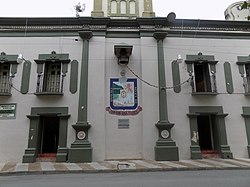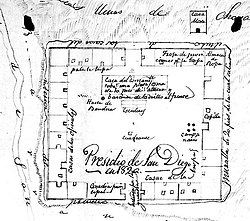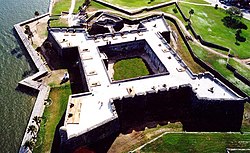
A presidio (jail, fortification) [1] was a fortified base established by the Spanish Empire mainly between the 16th and 18th centuries in areas under their control or influence. The term is derived from the Latin word praesidium meaning protection or defense.
Contents
- Canada
- Chile
- Italy
- Mexico
- Aguascalientes
- Baja California Sur
- Chihuahua
- Coahuila
- Durango
- Guanajuato
- Hidalgo
- Jalisco
- Nuevo León
- Querétaro
- San Luis Potosí
- Sonora
- Zacatecas
- North Africa
- Philippines
- Luzon
- Mindanao
- Visayas
- United States
- Arizona
- California
- Florida
- Georgia
- Louisiana
- New Mexico
- South Carolina
- Texas
- See also
- Notes
- References and further reading
In the Mediterranean and the Philippines, the presidios were outposts of the Christian defense against Islamic raids. In the Americas, the fortresses were built to protect against raids by pirates, rival colonial powers, and Native Americans.
Later in western North America, with independence, the Mexicans garrisoned the Spanish presidios on the northern frontier and followed the same pattern in unsettled frontier regions such as the Presidio de Sonoma in Sonoma, California, and the Presidio de Calabasas in Arizona.
In western North America, a rancho del rey or king's ranch would be established a short distance outside a presidio. This was a tract of land assigned to the presidio to furnish pasturage to the horses and other beasts of burden of the garrison. Mexico called this facility "rancho nacional". [2] Presidios were only accessible to Spanish military and soldiers.






![Presidio, Mezcala Island [es] Isla de Mezcala 11.jpg](http://upload.wikimedia.org/wikipedia/commons/thumb/4/4f/Isla_de_Mezcala_11.jpg/250px-Isla_de_Mezcala_11.jpg)


















